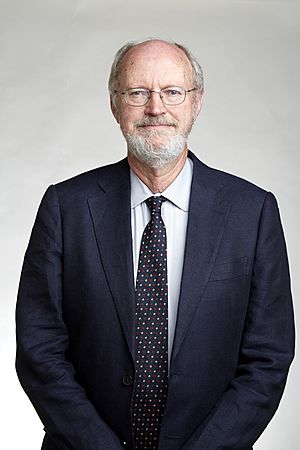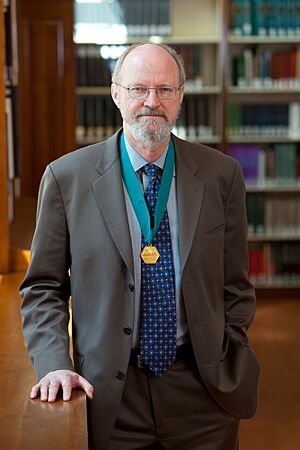Robert H. Grubbs facts for kids
Quick facts for kids
Robert H. Grubbs
|
|
|---|---|

Grubbs at the Royal Society admissions day in London in 2018
|
|
| Born |
Robert Howard Grubbs
February 27, 1942 |
| Died | December 19, 2021 (aged 79) Duarte, California, U.S.
|
| Education | University of Florida (BS) University of Florida (MS) Columbia University (PhD) |
| Known for | Catalysts for olefin metathesis in organic synthesis |
| Spouse(s) | Helen O'Kane |
| Awards |
|
| Scientific career | |
| Fields | Organic chemistry |
| Institutions | Stanford University Michigan State University California Institute of Technology |
| Thesis | I. Cyclobutadiene Derivatives II. Studies of Cyclooctatetraene Iron Tricarbonyl Complexes (1968) |
| Doctoral advisor | Ronald Breslow |
| Doctoral students |
|
Robert Howard Grubbs (February 27, 1942 – December 19, 2021) was an American chemist. He was a professor of chemistry at the California Institute of Technology in Pasadena, California. In 2005, he shared the Nobel Prize in Chemistry for his important work on a process called olefin metathesis.
Grubbs was also recognized for creating special substances called catalysts. These catalysts helped make many useful products that we use every day. He even helped start a company called Materia to produce these catalysts.
Contents
Early Life and Education
Robert Grubbs was born on February 27, 1942, on a farm in Marshall County, Kentucky. His mother, Faye, was a schoolteacher. After World War II, his family moved to Paducah, Kentucky. There, Robert went to Paducah Tilghman High School.
He first studied agriculture chemistry at the University of Florida. But his professor, Merle A. Battiste, encouraged him to switch to organic chemistry. This is the study of chemicals that contain carbon. Robert became very interested in how chemical reactions happen. He earned his first two degrees from the University of Florida in 1963 and 1965.
Later, Grubbs went to Columbia University. He worked with Ronald Breslow on "organometallic compounds." These are special chemicals that have bonds between carbon and metal atoms. Robert earned his PhD degree in 1968.
His Chemistry Career
After finishing his studies, Grubbs worked at Stanford University from 1968 to 1969. He started looking into how catalysts could help in organometallic chemistry. Catalysts are substances that speed up chemical reactions without being used up themselves.
In 1969, Grubbs joined Michigan State University. This is where he began his important work on olefin metathesis. This is a special chemical reaction that rearranges atoms in molecules. He was a professor there until 1978.
In 1978, Grubbs moved to the California Institute of Technology (Caltech). He became a full professor of chemistry. By 1990, he was named the Victor and Elizabeth Atkins Professor of Chemistry.
Making Discoveries Useful
Robert Grubbs co-founded a company called Materia in 1998. This company made the special catalysts he developed. These catalysts are known as "Grubbs catalysts." Materia sold these catalysts to other companies.
In 2008, Materia teamed up with Cargill to create Elevance Renewable Sciences. This new company made special chemicals from natural oils, including biofuels. Biofuels are fuels made from plants or animals. Later, Materia's catalyst business was sold to Umicore in 2017.
Amazing Research in Chemistry
Grubbs's main research was about creating new catalysts for olefin metathesis. In this process, a catalyst helps break and reform bonds between carbon atoms. This creates new chemical compounds with special features.
This basic technique can be used to make many things. These include polymers (like plastics), pharmaceuticals (medicines), and petrochemicals. It has many uses in areas like biotechnology and agriculture.
Grubbs was key in developing a group of ruthenium catalysts. These are known as Grubbs catalysts. He studied how these catalysts could be used for different reactions. These included "ring-closing metathesis" (RCM) and "ring-opening metathesis polymerization" (ROMP).
His work led to the first "Grubbs catalyst" becoming available for everyone to use in 1995. Later, even better versions were developed.
Ruthenium catalysts are special because they are stable in the air. They also work very well and are safer than older catalysts. Grubbs also used a "green chemistry" approach. This means his methods created less harmful waste. The Grubbs catalyst is now a common tool for chemists around the world.
By controlling the catalyst, chemists can make polymers with very specific structures. This helps create new materials with unique properties. Using these catalysts makes chemical changes faster and cheaper.
Personal Life
While studying at Columbia University, Robert Grubbs met Helen O'Kane. She was a special-education teacher. They got married and had three children: Barney, Brendan, and Kathleen.
Robert Grubbs passed away on December 19, 2021, at the age of 79. He died from a heart attack while being treated for lymphoma.
Awards and Honors
Robert Grubbs received the 2005 Nobel Prize in Chemistry. He shared it with Richard R. Schrock and Yves Chauvin. This award was for their groundbreaking work on olefin metathesis. He also received many other important awards:
- 1989: National Academy of Sciences
- 1994: American Academy of Arts and Sciences
- 2000: Benjamin Franklin Medal in Chemistry
- 2002: Tolman Medal
- 2005: Honorary Fellow of the Royal Society of Chemistry
- 2005: Paul Karrer Gold Medal
- 2006: Golden Plate Award of the American Academy of Achievement
- 2010: American Institute of Chemists Gold Medal
- 2015: Inducted into the Florida Inventors Hall of Fame
- 2015: National Academy of Engineering
- 2017: Elected a Foreign Member of the Royal Society
See also
 In Spanish: Robert Howard Grubbs para niños
In Spanish: Robert Howard Grubbs para niños



